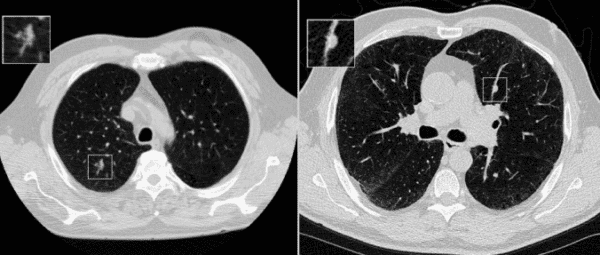|
CADx’s Lung Nodule Impact | Automatic Reporting
September 7, 2022
|
|
|

|
|
Together with
|

|
|
|
“If everything is ordered STAT nothing is STAT.”
|
|
A philosophical tweet from radiologist Mahad Minhas, MD.
|
|
|
I’m excited to share the latest Imaging Wire Show, featuring ScreenPoint Medical CEO, Mark Koeniguer. We discuss breast imaging’s evolution and how ScreenPoint is driving the future of breast AI, making this a must-watch episode if you’re a breast radiologist or responsible for your practice’s accuracy and efficiency.
|
|

|
|
A new JACR study highlighted Computer-Aided Diagnosis (CADx) AI’s ability to improve lung nodule malignancy risk classifications, while stating a solid case for the technology’s potential clinical role.
The researchers applied RevealDx’s RevealAI-Lung CADx solution to chest CTs from 963 patients with 1,331 nodules (from 2 LC screening datasets, and one incidental nodule dataset), finding that RevealAI-Lung’s malignancy risk scores (mSI) combined with Lung-RADS would significantly improve…
- Sensitivity versus Lung-RADS-only (3 cohorts: +25%, +68%, +117%)
- Specificity versus Lung-RADS-only (3 cohorts: +17%, +18%, +33%)
Looking specifically at the study’s NLST cohort (704 nodules), mSI+Lung-RADS would have…
- Reclassified 94 nodules to “high risk” (formerly false-negatives)
- Potentially diagnosed 53 patients with malignant nodules at least one year earlier
- Reclassified 36 benign nodules to “low-risk” (formerly false-positives)
The RevealDx-based malignancy scores also achieved comparable accuracy to existing clinical risk models when used independently (AUCs: 0.89 vs. 0.86 – 0.88).
The Takeaway
These results suggest that a CADx lung nodule solution like RevealAI-Lung could significantly improve lung nodule severity assessments. Considering the clinical importance of early and accurate diagnosis of high-risk nodules and the many negatives associated with improper diagnosis of low-risk nodules (costs, efficiency, procedures, patient burden), that could be a big deal.
|




|
|
Qure.ai & CARPL.ai’s Real Time Validation
Faced with the task of monitoring the thousands of exams its algorithms analyze each day, Qure.ai leveraged CARPL.ai’s validation workflow to create a real-time performance dashboard. See how they did it here.
|
|
Photon-Counting CT’s Technology Foundation
Siemens Healthineers’ NAEOTOM Alpha made headlines as the world’s first photon-counting CT system, a technology that’s poised to redefine CT imaging. Check out this whitepaper detailing how the NAEOTOM Alpha’s unique resolution, contrast-to-noise ratio, and spectral sensitivity advantages could change CT forever.
|
|
- Automatic Reporting Milestone: Some of the biggest names in imaging AI published what might be key building blocks for future image-based radiology report generation systems (AI that automatically creates rad reports based on images). Although the new paper and code are most appropriate for AI insiders, the main takeaway for everyone else is that developers now have new metrics and processes that they can use to improve their report generation models, potentially leading to automated reports that “approach the level of radiologists.”
- Teleultrasound’s Pediatric Potential: New research out of France highlighted teleultrasound’s potential for emergency pediatric cases, particularly for hospital locations or shifts that don’t staff on-site pediatric radiologists. The researchers performed 3D ultrasound exams on 103 children with abdominal pain that were interpreted remotely by two radiologists (senior rad & rad resident), finding that the remote readings were often “good to excellent” (84.6% & 70%), and achieved promising sensitivity (86% & 84%) and specificity (95% & 92%) compared to the standard on-site exams.
- VinBrain’s CXR AI 510(k): Vietnam-based AI startup VinBrain announced the FDA clearance of its DrAid chest X-ray AI solution, which automatically detects 21 different CXR abnormalities in 15 seconds. VinBrain joins a growing multi-abnormality CXR AI segment, which features products from a number of international startups with solid funding and mounting academic evidence (annalise.ai, Lunit, Qure.ai, Oxipit, Vuno).
- CMRI and PET Comparable for CAD: In a head-to-head comparison, cardiac MRI and PET with rubidium (RbPET) identified coronary artery disease to nearly identical degrees. Using fractional flow reserve assessment via invasive coronary angiography as the reference (n= 372 patients w/ suspected stenosis), CMR and RbPET showed no significant differences in sensitivity (59% vs. 64%), specificity (84% vs. 89%), and positive and negative predictive values.
- Radiology’s AI Recruitment Barrier: A new Brown University study suggests that concerns about AI and other emerging technologies (ET) are steering medical students away from diagnostic radiology. In the study’s 2017 and 2021 surveys (n = 384 & 321), the ratio of med students who would not consider radiology due to ET concerns remained flat at 23% (higher than all other specialties). However, students who participated in both surveys showed growing concerns about ET’s future impact on radiology job prospects (50% to 71%) and increasingly decided not to pursue radiology because of their ET concerns (20% to 23%).
- PC-CT’s Multiple Myeloma Advantage: A Radiology Journal study highlighted photon-counting CT’s advantage over standard CT for assessing multiple myeloma lesions, especially when enhanced with deep learning noise reduction technology. The researchers scanned 27 multiple myeloma patients using Siemens Healthineers’ Naeotom Alpha PC-CT and a standard EID CT scanner, finding that PC-CT allowed superior viewing of lytic lesions, intramedullary lesions, and fatty metamorphosis (P < .001). When they processed the exams using noise reduction technology, the enhanced PC-CT images detected at least one more lytic lesion than EID CT in 21 of the patients.
- Hexarad Adds £2.2M: UK-based teleradiology and radiology software developer Hexarad added another £2.2M to its now-complete Series A round (following £2.3M in Sept 2021), revealing plans to use the funding to enhance its radiology efficiency platform and expand to new UK clients. In addition to providing telerad support, Hexarad’s platform analyzes radiology departments’ workforces and helps them efficiently deploy staff (locations, specialties, staffing levels, etc.).
- BC VFA, a CVD Risk Marker: A new AJR study highlighted automated CT-based body composition (BC) analysis’ potential to identify patients with high visceral fat area (VFA) and greater risks of future cardiovascular events. Using routine abdominal CTs from 9,752 patients and an automated AI-based BC analysis system, the researchers produced three automated BC measurements (skeletal muscle area, subcutaneous fat area, and VFA), finding that patients with the highest VFA measurements had greater future risks of heart attack and stroke than patients with the lowest VFAs (hazard ratios: 1.31 & 1.46).
- BAC Risk Demographics: A team of New York-based researchers provided new insights into how demographics impact patients’ risk of having breast arterial calcifications (BAC) in their screening mammograms, noting that BAC is a possible biomarker for coronary artery disease. A review of 17k women’s mammograms (12.3% w/ BAC) found that BAC risks were far greater among racial minorities (e.g. Hispanic women have 2.67-fold greater risk vs. non-Hispanics) and older women (e.g. women aged 55-64yrs have 5.98-fold greater risk of BAC vs. women <44yrs).
- CurveBeam & StraxCorp’s AI Merger: Point-of-care CT vendor CurveBeam and AI startup StraxCorp announced plans to merge, forming CurveBeam AI Limited. The merger of these longtime partners will combine CurveBeam’s weight bearing CT imaging systems (WBCT) with StraxCorp’s orthopedic and bone health AI solutions, placing a strategic focus on fragility fracture detection/prevention and AI-enhanced WBCT imaging.
- FFR vs. IVUS Patient Outcomes: A NEJM-published study found FFR guidance for percutaneous coronary intervention did not result in worse patient outcomes than intravascular ultrasonography (IVUS). Researchers randomized 1.7k patients with intermediate stenosis (based on visual estimation) to undergo either an FFR- or IVUS-guided procedure. At two years post-procedure, both groups had a similar rate of composite death, heart attack, and revascularization (8.1% vs. 8.5%), as well as similar self-reported chest pain symptoms.
|
|
Validating ClearRead CT
It says a lot when a solution works so well for a radiology department that they decide to perform a study to quantify its benefits. In this Imaging Wire Q&A, University Hospital of Zurich’s Thomas Frauenfelder discusses his experience and study on Riverain Technologies ClearRead CT.
|
|
- Digitization and AI are an era-defining reality for radiology, and GE Healthcare is rising to the challenge by creating tools to build a world that works better for healthcare. Check out this report detailing GE’s digitization and AI innovations and its vision for precision healthcare.
- Hyperfine’s Swoop Portable MR Imaging System is redefining MR accessibility, but do you know how the Swoop is actually being used? Check out this case study detailing the clinical settings and patient scenarios that the Swoop is supporting today.
- Curious how certain your AI is about its own finding? annalise.ai’s confidence bar displays the likelihood of each finding and the AI model’s level of certainty, helping clinicians perform their interpretations with greater confidence.
- During 25 years in the imaging informatics trenches you see a lot of patched together solutions to data governance problems. See how these work-arounds helped shape Enlitic product leader Rocky Lien’s vision for what can be accomplished using Curie|ENDEX.
- Bayer’s cloud-based Calantic Digital Solutions AI platform features a suite of disease-specific AI apps that integrate into radiologist workflows, helping radiology teams scale AI deployment and improve efficiency and quality of care.
- With ongoing radiologist shortages and higher rates of burnout, there’s a great need for fast, effective, efficient medical imaging technologies – and those factors are driving 2022’s major medical imaging trends detailed in this Arterys report.
- See how 2-meter total body PET gives molecular imaging teams a diagnostic advantage compared to other “eyes to thighs” PET options in this editorial by United Imaging CEO Jeffrey M. Bundy.
|
|
|
|
|